Design and Performance Analysis of a Saturated Iron-Core Superconducting Fault Current Limiter for DC Power Systems
Abstract
1. Introduction
2. Conceptual Design of the SI-SFCL for a DC Power System
2.1. Fault Current Characteristic in the VSC-DC Power System
2.2. Configuration and Specifications of the Lab-Scale SI-SFCL
3. Design of the Coil System for the Lab-Scale SI-SFCL
3.1. Design of the SSC
3.2. Design of the CPC
4. Experiment Results and Discussions
4.1. Fabrication and Pre-Testing of the Lab-Scale SI-SFCL
4.2. Experiment Circuit for Testing the DC Fault
4.3. Performance Analysis of the Lab-Scale SI-SFCL
5. Conclusions
Author Contributions
Funding
Conflicts of Interest
References
- Rafferty, J.; Morrow, D.J.; Xu, L. Analysis of VSC-based HVDC system under DC faults. In Proceedings of the 39th Annual Conference of the IEEE Industrial Electronics Society IECON 2013, Austria Center Vienna, Vienna, Austria, 10–14 November 2013; pp. 459–464. [Google Scholar] [CrossRef]
- Ahmed, W.; Manohar, P. DC line protection for VSC-HVDC system. In Proceedings of the 2012 IEEE International Conference on Power Electronics, Drives and Energy Systems (PEDES), Bangaluru, India, 16–19 December 2012; Institute of Electrical and Electronics Engineers (IEEE): Piscataway, NJ, USA, 2012; pp. 1–6. [Google Scholar] [CrossRef]
- Hwang, S.H.; Choi, H.-W.; Jeong, I.-S.; Choi, H.-S. Characteristics of DC Circuit Breaker Applying Transformer-Type Superconducting Fault Current Limiter. IEEE Trans. Appl. Supercond. 2018, 28, 1–5. [Google Scholar] [CrossRef]
- Hong, Y.; Yu, T. Reliability Improvement Strategies for HVDC Transmission System. Energy Power Eng. 2013, 5, 52–56. [Google Scholar] [CrossRef]
- Tang, L.; Ooi, B.-T. Protection of VSC-multi-terminal HVDC against DC faults. In Proceedings of the 2002 IEEE 33rd Annual IEEE Power Electronics Specialists Conference, Cairns, Qld., Australia, 23–27 June 2002; pp. 719–724. [Google Scholar] [CrossRef]
- Rafferty, J.; Xu, L.; Morrow, D.J. DC fault analysis of VSC based multi-terminal HVDC systems. In Proceedings of the 10th IET International Conference on AC and DC Power Transmission (ACDC 2012), Birmingham, UK, 4–5 December 2012; pp. 1–6. [Google Scholar] [CrossRef]
- Franck, C.M. HVDC Circuit Breakers: A Review Identifying Future Research Needs. IEEE Trans. Power Deliv. 2011, 26, 998–1007. [Google Scholar] [CrossRef]
- Tahata, K.; Ito, H.; Yamamoto, R. HVDC circuit breakers for HVDC grid applications. In Proceedings of the 11th IET International Conference on AC and DC Power Transmission, Birmingham, UK, 10–12 February 2015; p. 044. [Google Scholar] [CrossRef]
- Pei, X.; Smith, A.C.; Barnes, M. Superconducting Fault Current Limiters for HVDC Systems. Energy Procedia 2015, 80, 47–55. [Google Scholar] [CrossRef]
- Chen, Y.; Liu, X.; Sheng, J.; Cai, L.; Jin, Z.; Gu, J.; An, Z.; Yang, X.; Hong, Z. Design and Application of a Superconducting Fault Current Limiter in DC Systems. IEEE Trans. Appl. Supercond. 2013, 24, 1–5. [Google Scholar] [CrossRef]
- Lee, H.-Y.; Asif, M.; Park, K.-H.; Lee, B.-W. Feasible Application Study of Several Types of Superconducting Fault Current Limiters in HVDC Grids. IEEE Trans. Appl. Supercond. 2018, 28, 1–5. [Google Scholar] [CrossRef]
- Zhang, L.; Shi, J.; Wang, Z.; Tang, Y.; Yang, Z.; Ren, L.; Yan, S.; Liao, Y. Application of a Novel Superconducting Fault Current Limiter in a VSC-HVDC System. IEEE Trans. Appl. Supercond. 2017, 27, 1–6. [Google Scholar] [CrossRef]
- Zhu, J.; Li, Y.; Duan, X. Application of SFCLs to Inhibit Commutation Failure in HVdc Systems: Position Comparison and Resistance Recommendation. Can. J. Electr. Comput. Eng. 2017, 40, 31–40. [Google Scholar]
- Xiang, B.; Yang, K.; Tan, Y.; Liu, Z.; Geng, Y.; Wang, J.; Yanabu, S. DC-Current-Limiting Characteristics of YBCO Tapes for DC Currents of 50 A to 10 kA. IEEE Trans. Appl. Supercond. 2017, 27, 1–5. [Google Scholar] [CrossRef]
- Yang, Q.; le Blond, S.; Liang, F.; Yuan, W.; Zhang, M.; Li, J. Design and Application of Superconducting Fault Current Limiter in a Multiterminal HVDC System. IEEE Trans. Appl. Supercond. 2017, 27, 1–5. [Google Scholar] [CrossRef]
- Morishita, Y.; Ishikawa, T.; Yamaguchi, I.; Okabe, S.; Ueta, G.; Yanabu, S. Applications of DC Breakers and Concepts for Superconducting Fault-Current Limiter for a DC Distribution Network. IEEE Trans. Appl. Supercond. 2009, 19, 3658–3664. [Google Scholar] [CrossRef]
- Li, B.; Cui, H.; Jing, F.; Li, B.; Liu, Y. Current-limiting characteristics of saturated iron-core fault current limiters in VSC-HVDC systems based on electromagnetic energy conversion mechanism. J. Mod. Power Syst. Clean Energy 2018, 7, 412–421. [Google Scholar] [CrossRef]
- Li, B.T.; Jia, J.F.; Li, B.; Zhang, Y.K. Fault analysis of VSC-HVDC system with saturated iron-core superconductive fault current limiter. In Proceedings of the 2015 IEEE International Conference on Applied Superconductivity and Electromagnetic Devices (ASEMD), Shanghai, China, 20–23 November; pp. 388–390. [CrossRef]
- Wang, C.; Li, B.; He, J.; Xin, Y. Design and Application of the SFCL in the Modular Multilevel Converter Based DC System. IEEE Trans. Appl. Supercond. 2017, 27, 1–4. [Google Scholar] [CrossRef]
- Li, B.; Jing, F.; Jia, J.; Li, B. Research on Saturated Iron-Core Superconductive Fault Current Limiters Applied in VSC-HVDC Systems. IEEE Trans. Appl. Supercond. 2016, 26, 1–5. [Google Scholar] [CrossRef]
- Li, B.; Jing, F.; Li, B.; Chen, X.; Jia, J. Study of the Application of Active Saturated Iron-Core Superconductive Fault Current Limiters in the VSC-HVDC System. IEEE Trans. Appl. Supercond. 2018, 28, 1–6. [Google Scholar] [CrossRef]
- Xin, Y.; Gong, W.Z.; Gao, Y.Q.; Niu, X.Y.; Guo, Q.Q. Introduction of 35 kV/90 MVA saturated iron-core superconducting fault current limiter. Rare Met. Mater. Eng. 2008, 37, 275–280. [Google Scholar]
- Gong, W.; Zhang, J.; Cao, Z.; Hong, H.; Tian, B.; Wang, Y.; Wang, J.; Niu, X.; Qiu, J.; Wang, S.; et al. HTS dc bias coil for 35kV/90MVA saturated iron-core fault current limiter. Phys. C Supercond. 2008, 468, 2050–2053. [Google Scholar] [CrossRef]
- Pellecchia, A.; Klaus, D.; Masullo, G.; Marabotto, R.; Morandi, A.; Fabbri, M.; Goodhand, C.; Helm, J.; Antonio, P. Development of a Saturated Core Fault Current Limiter with Open Magnetic Cores and Magnesium Diboride Saturating Coils. IEEE Trans. Appl. Supercond. 2016, 27, 1. [Google Scholar] [CrossRef]
- Moriconi, F.; de la Rosa, F.; Darmann, F.; Nelson, A.; Masur, L. Development and Deployment of Saturated-Core Fault Current Limiters in Distribution and Transmission Substations. IEEE Trans. Appl. Supercond. 2011, 21, 1288–1293. [Google Scholar] [CrossRef]
- Yang, J.; Fletcher, J.E.; O’Reilly, J. Short-Circuit and Ground Fault Analyses and Location in VSC-Based DC Network Cables. IEEE Trans. Ind. Electron. 2012, 59, 3827–3837. [Google Scholar] [CrossRef]
- Dao, V.Q.; Lee, J.; Kim, C.-S.; Park, M. Conceptual Design of a Saturated Iron-Core Superconducting Fault Current Limiter for a DC Power System. IEEE Trans. Appl. Supercond. 2020, 30, 1–5. [Google Scholar] [CrossRef]
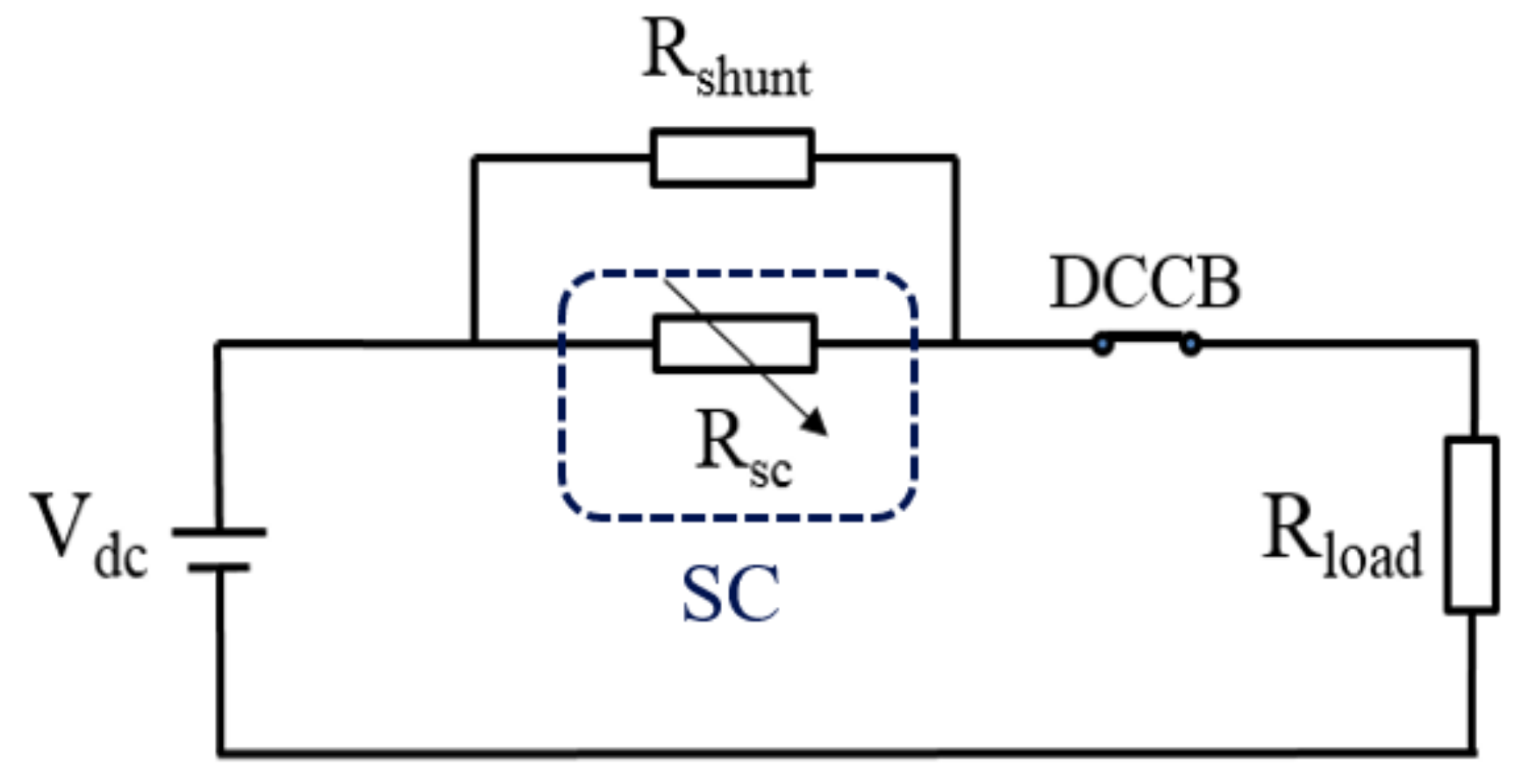
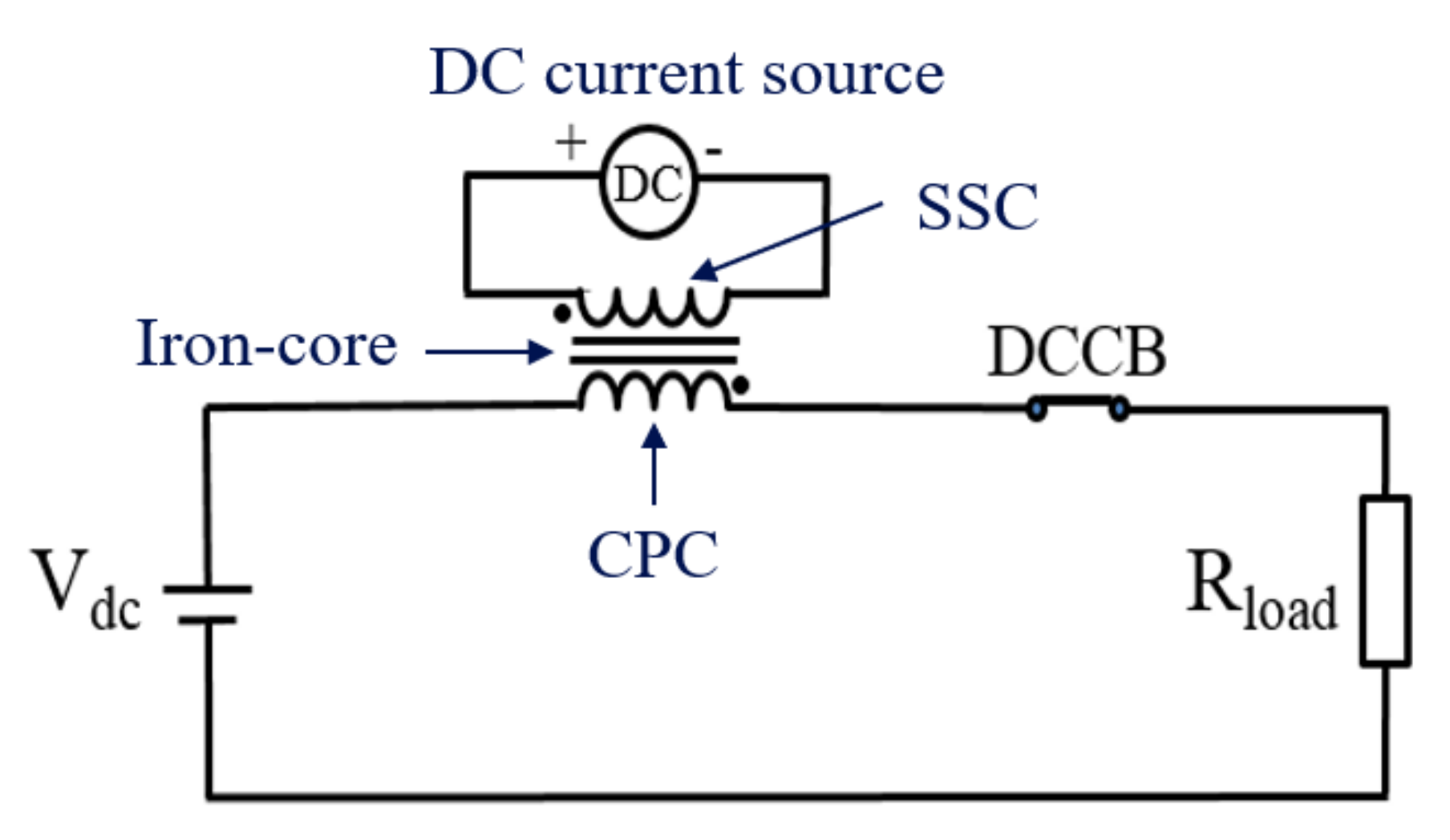
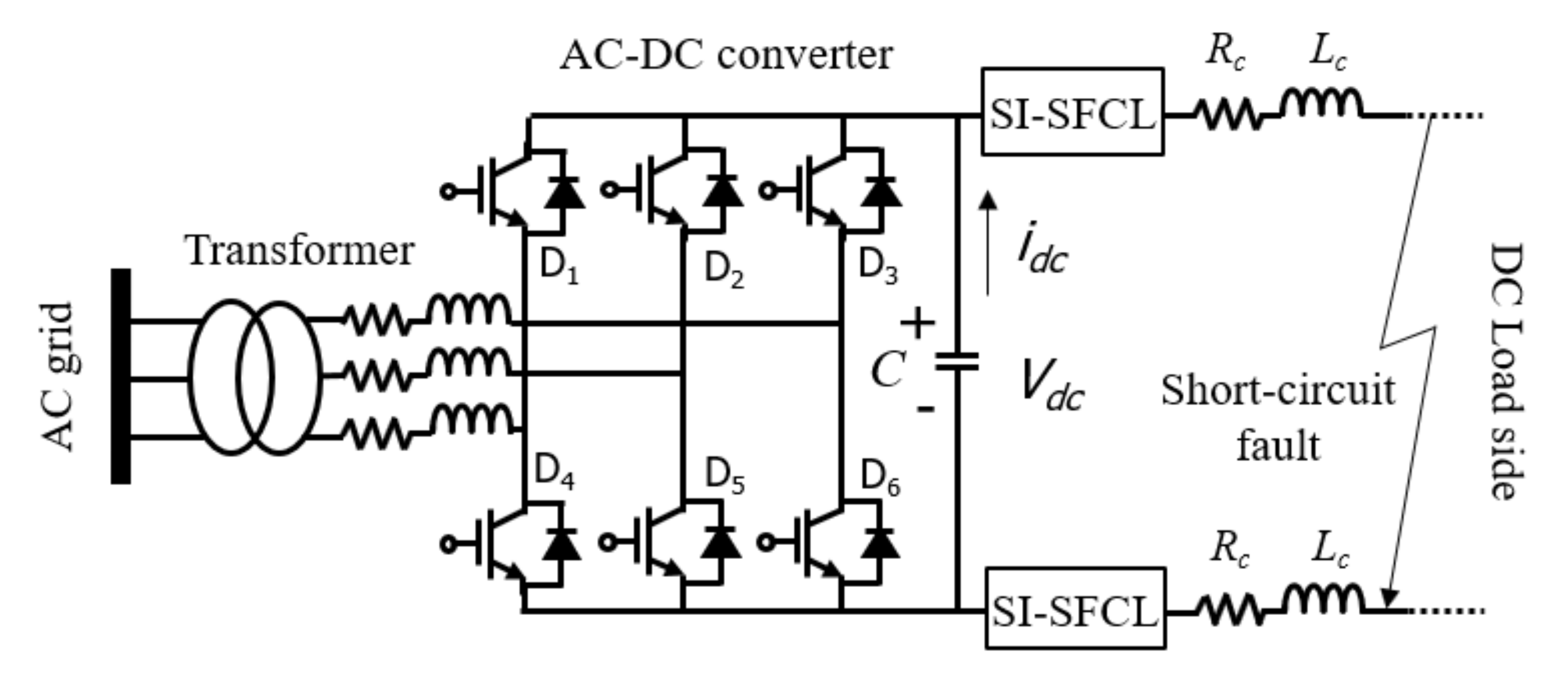
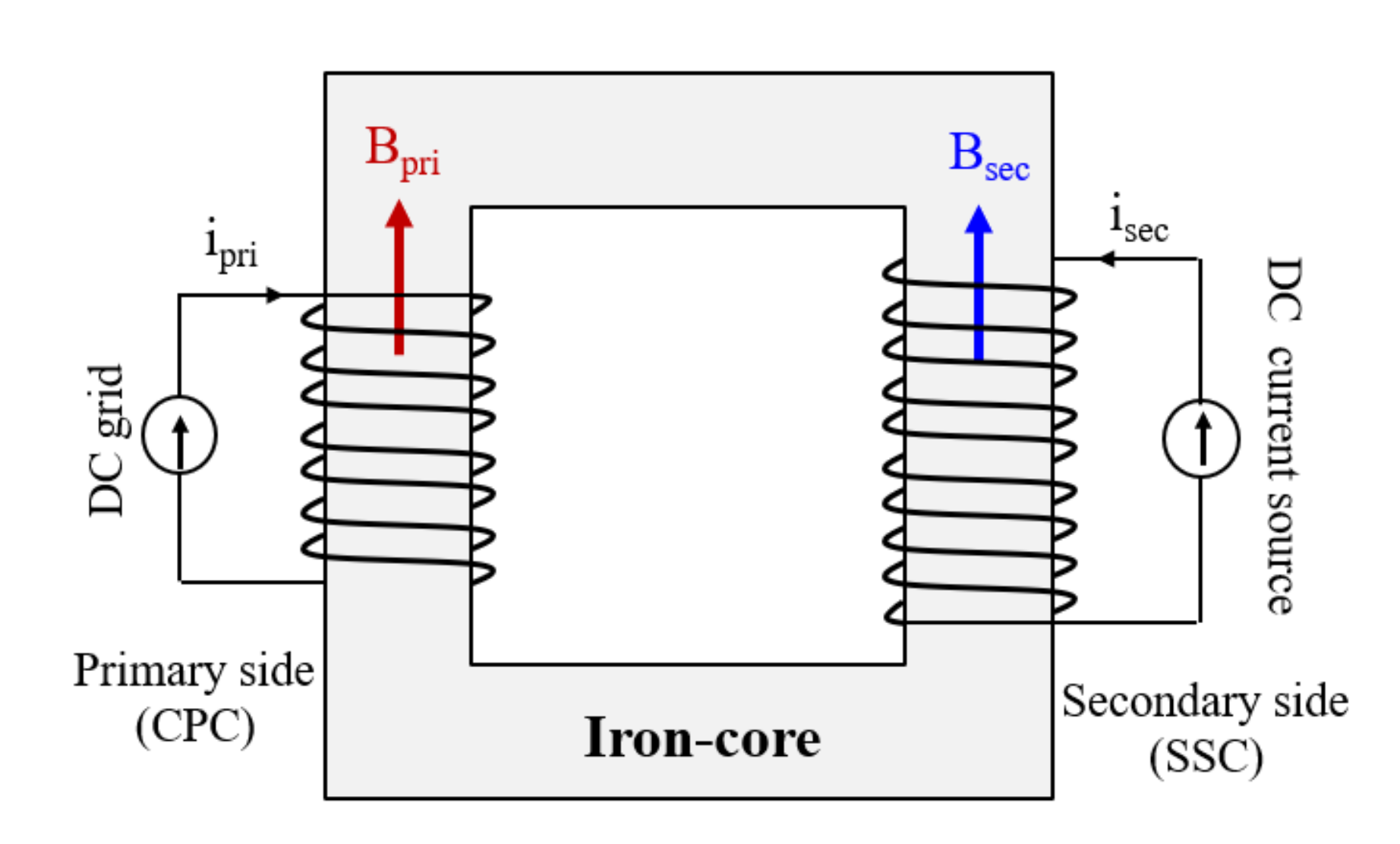
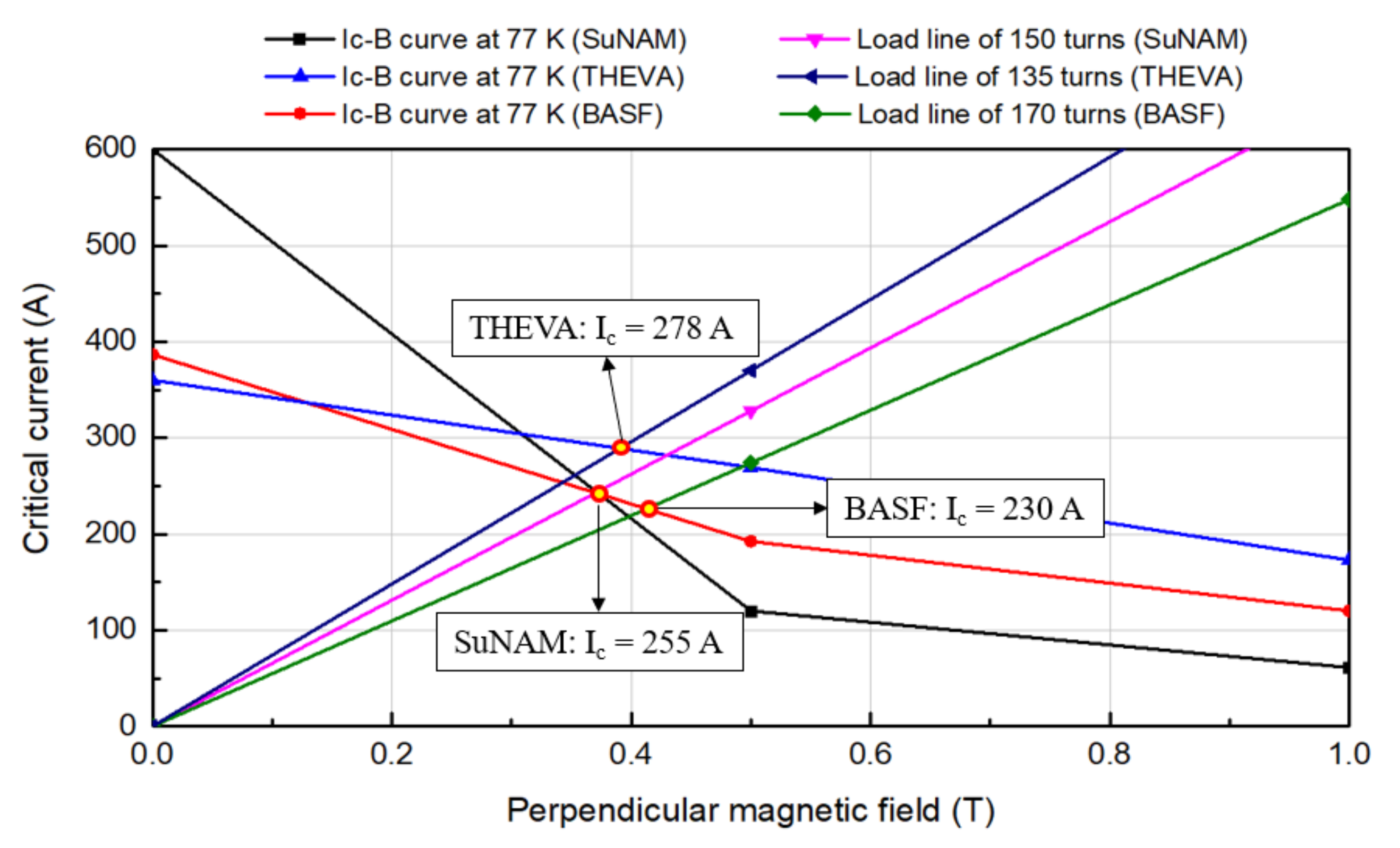

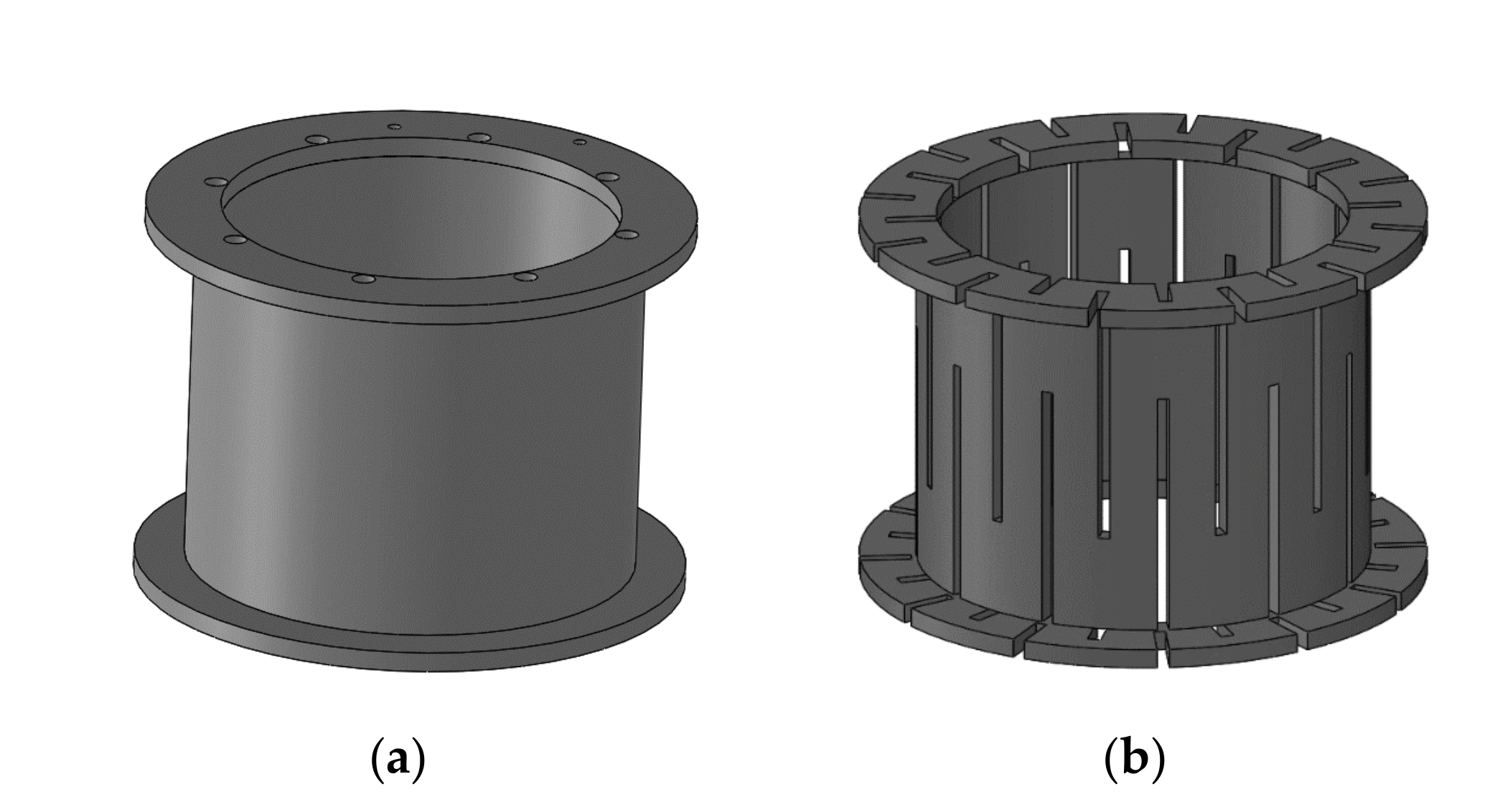
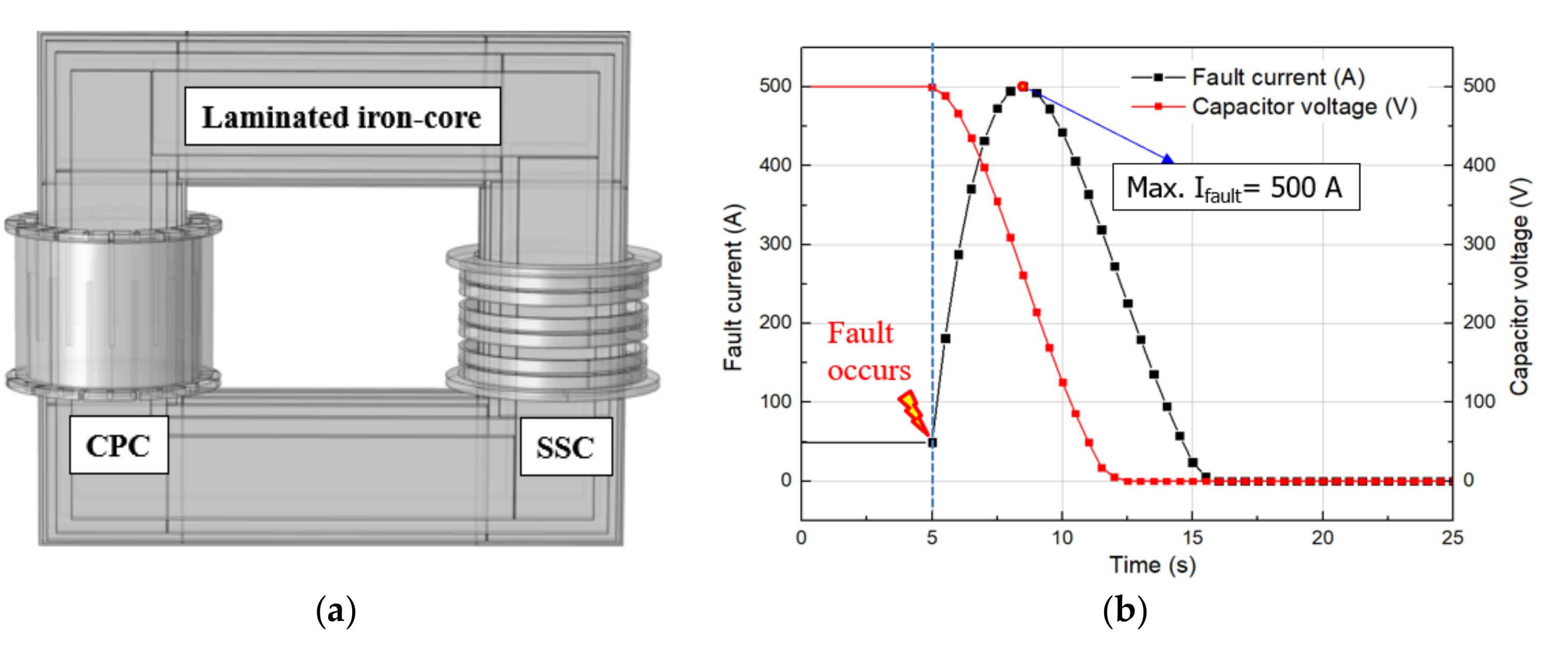
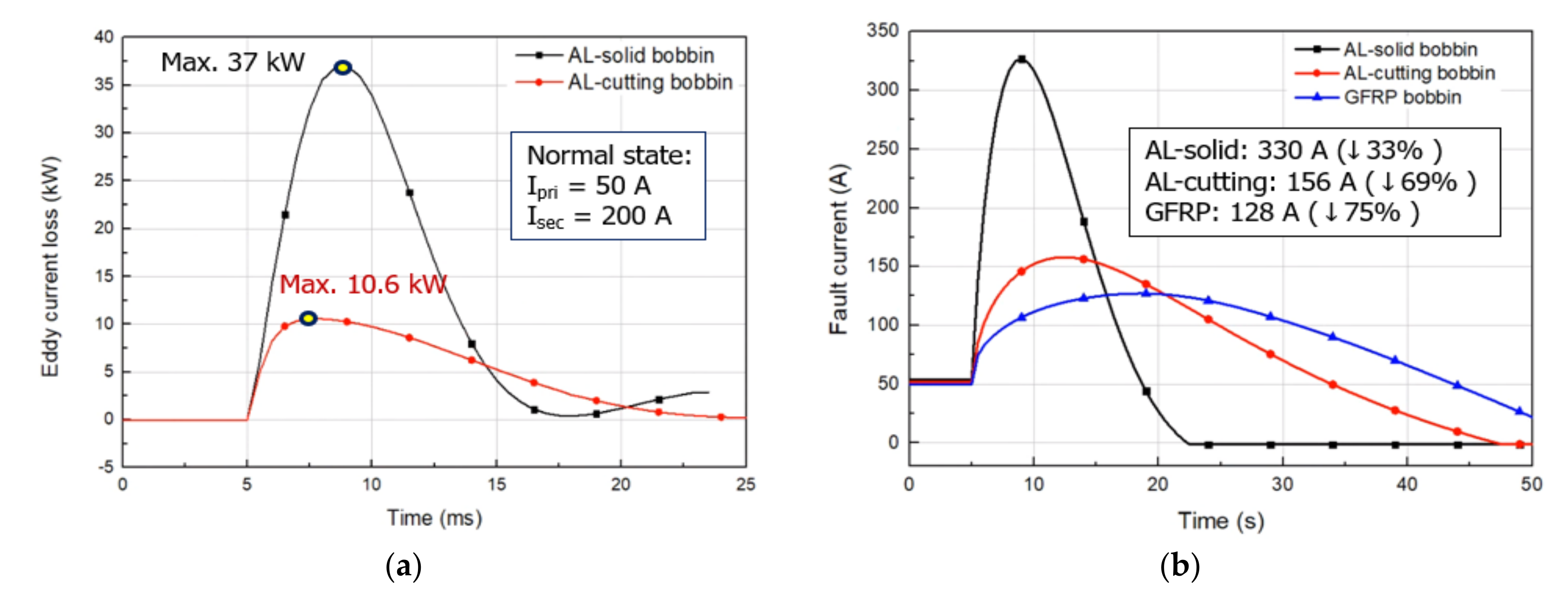

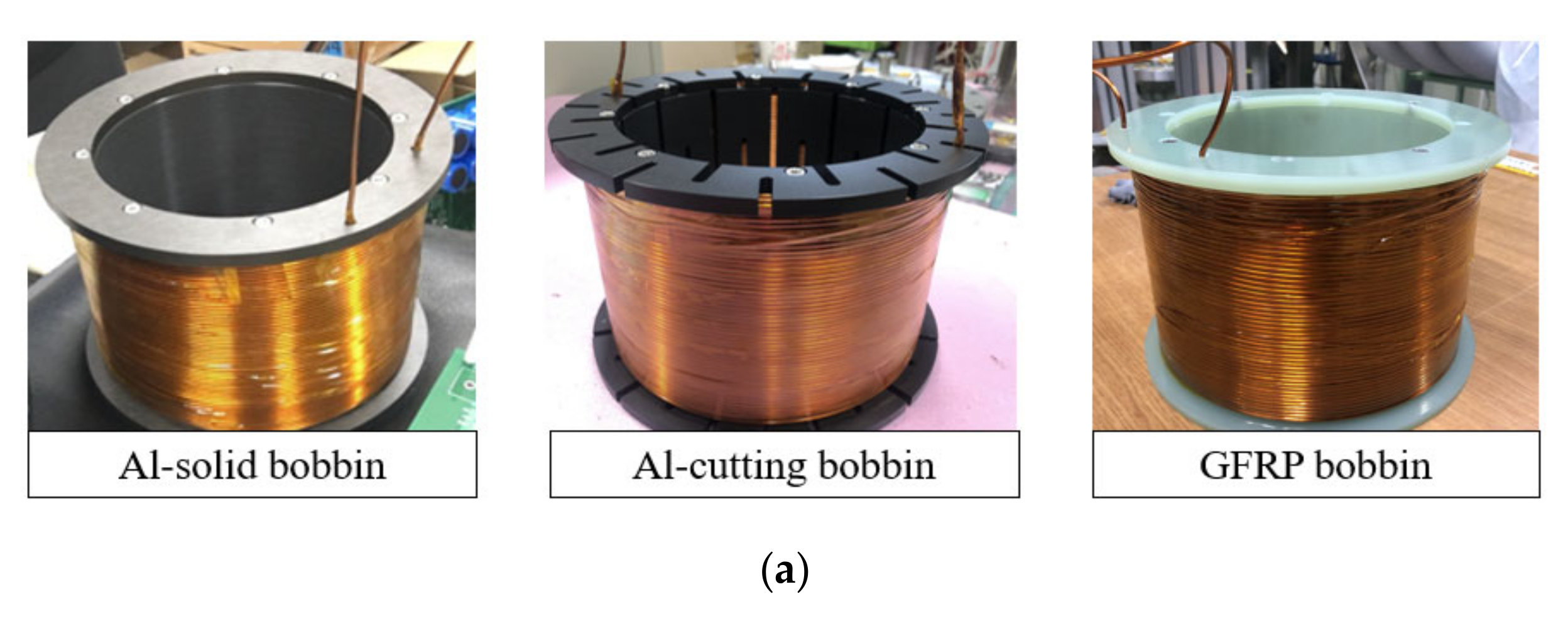

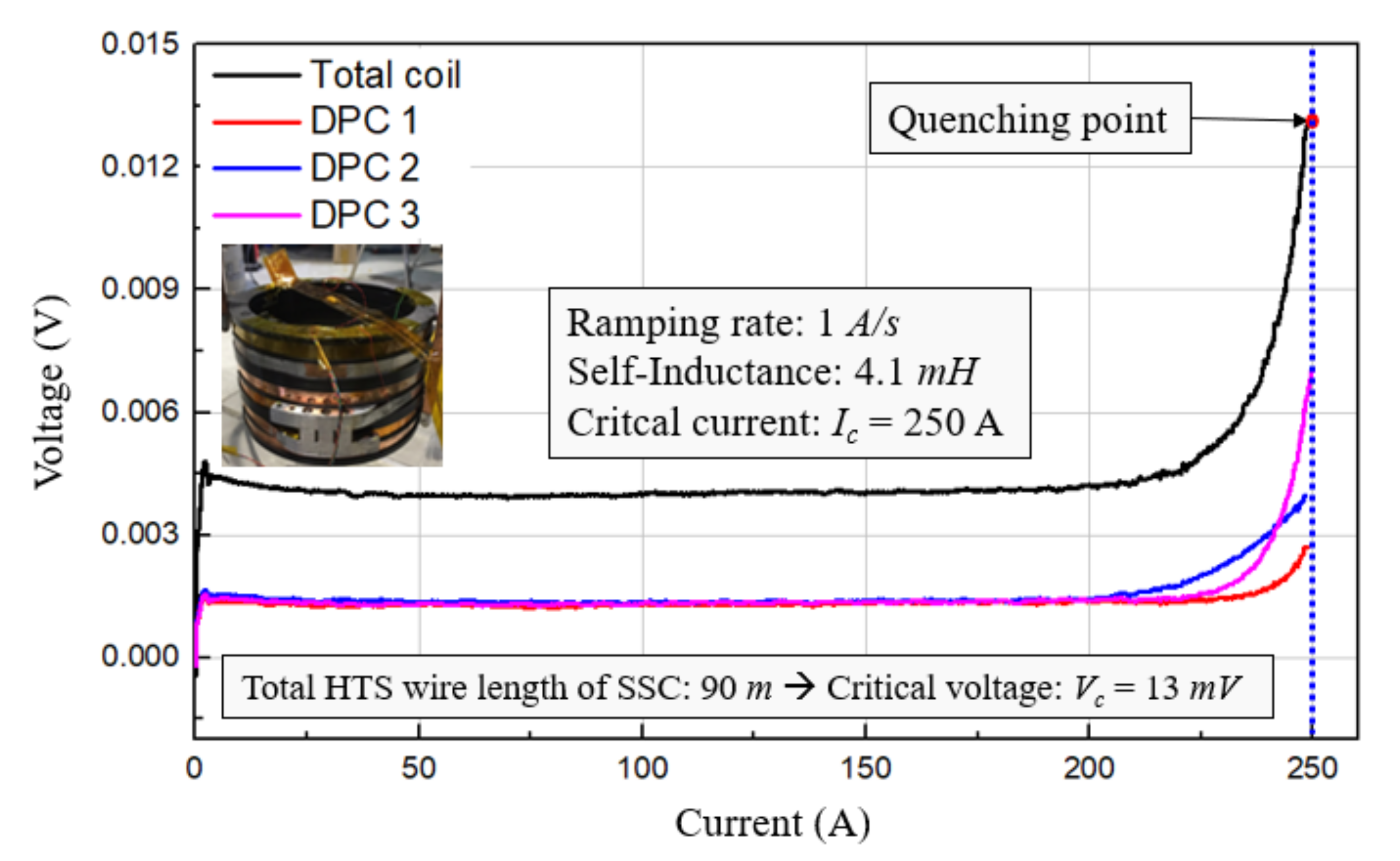
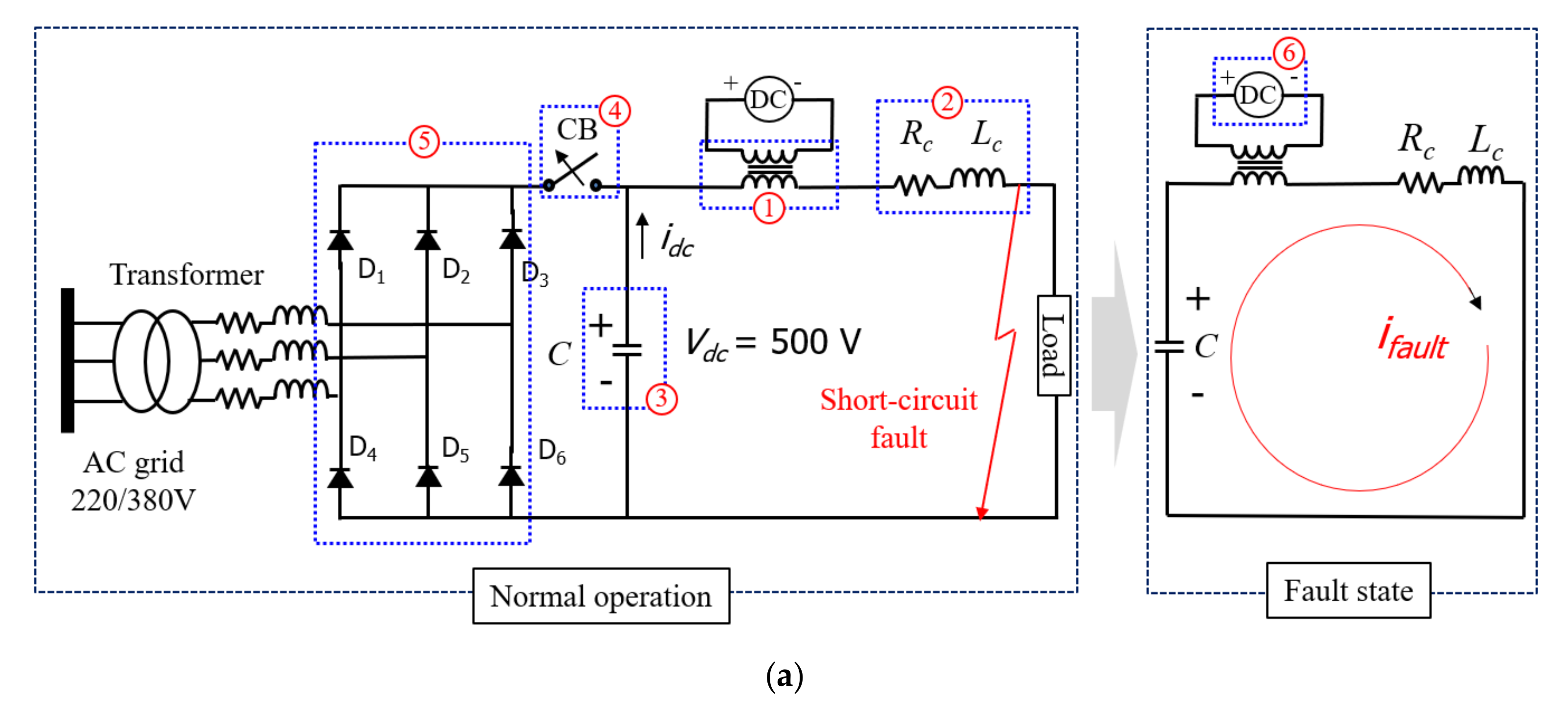
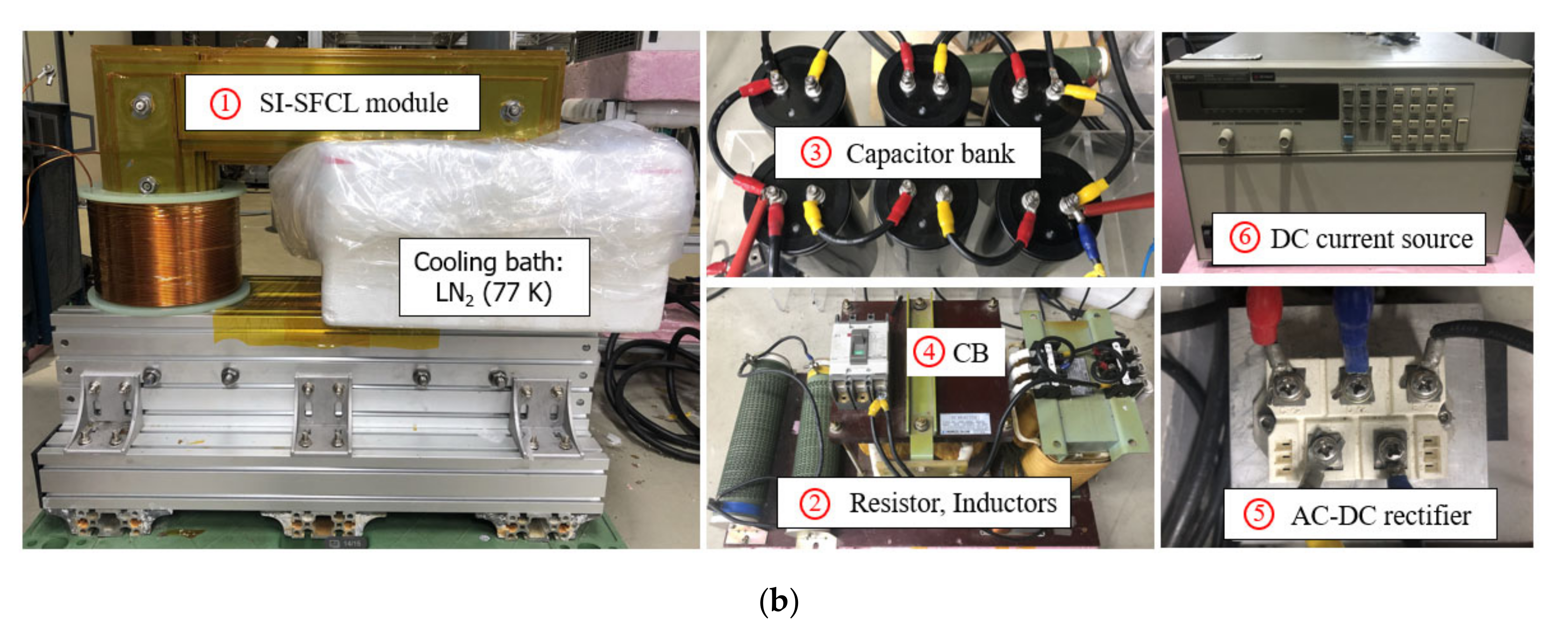
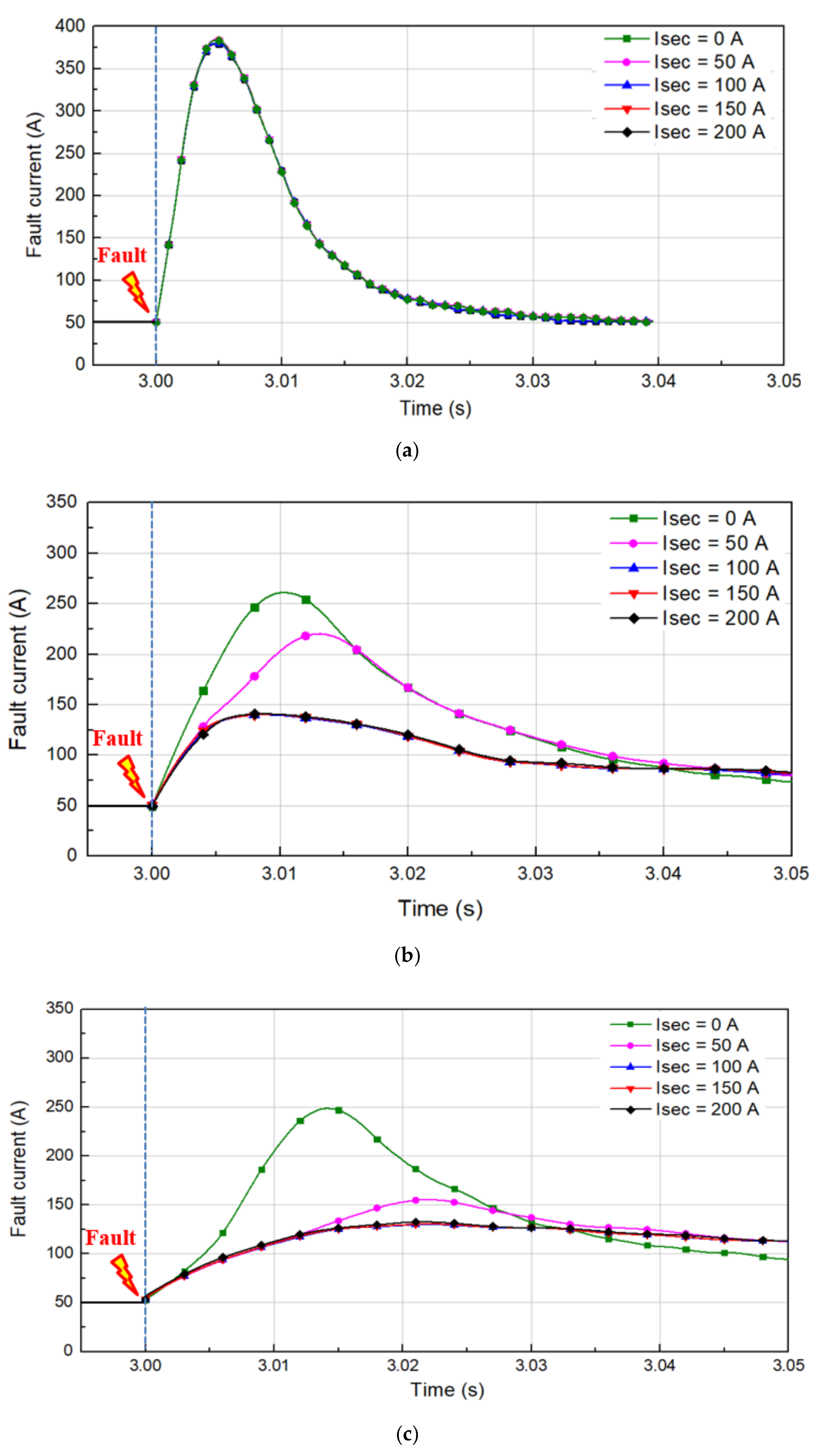

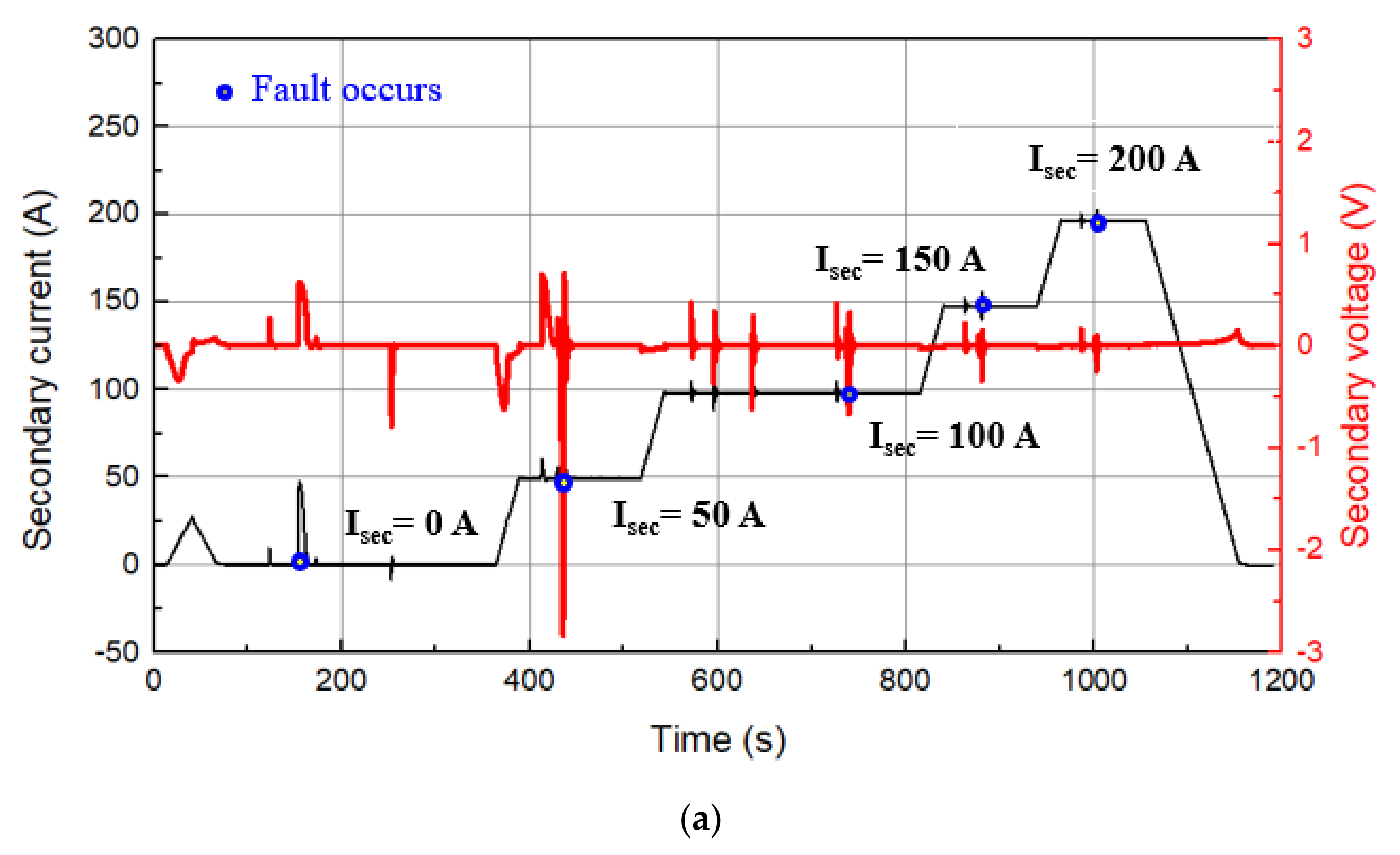
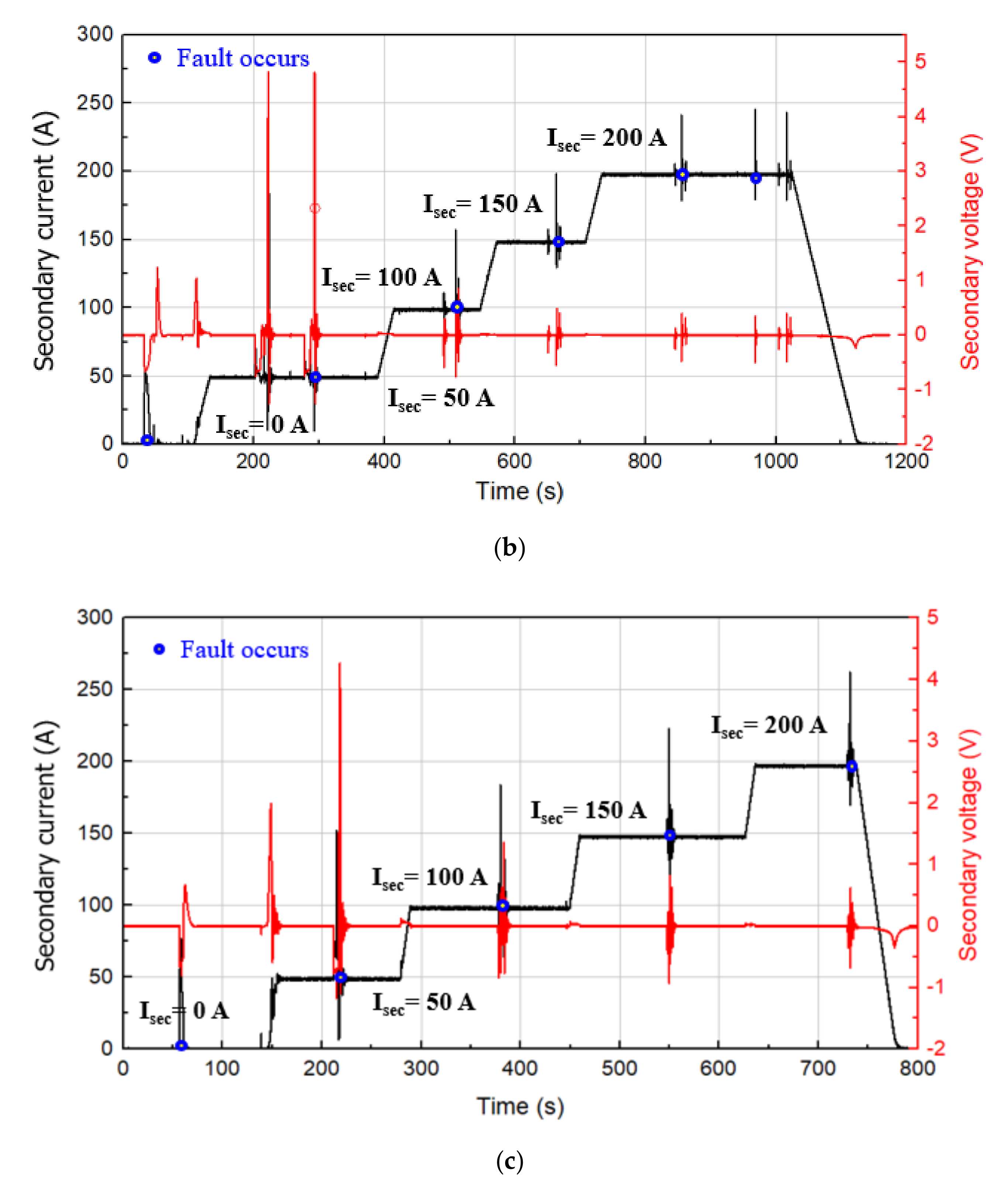
| Items | Values |
|---|---|
| Normal voltage of DC system, Vc | 500 V |
| Normal current of DC system, Ic | 50 A |
| Rated power of DC system, Pm | 25 kW |
| DC line resistance, Rc | 0.5 Ω |
| DC line inductance, Lc | 1.651 mH |
| Capacitor bank, C | 5300 µF |
| Fault current without the SI-SFCL | 500 A |
| Target of fault limitation rate | >70% |
| Core material | 50PN470 |
| Saturated magnetic field of the iron-core, Bmax | 1.7 T |
| Cross-section area of the iron-core, Acore | 0.01 m2 |
| Length of the magnetic path in the iron-core, lcore | 1.6 m |
| Number of turns in the CPC, Npri | 198 turns |
| Air-core inductance of the CPC, Lpri | 6 mH |
| Items | A1 | A2 | A3 |
|---|---|---|---|
| Wire shape | Laminated tape | Laminated | Laminated tape |
| Dimension (width × thickness) | 12.1 mm × 0.22 mm | 12 mm × 0.23 mm | 10 mm × 0.15 mm |
| Critical bend radius | 30 mm | 30 mm | 60 mm |
| Critical ten. strength | 550 MPa | 300 MPa | 250 MPa |
| Critical current at 77 K, 0 T | 600 A | 500 A | 380 A |
| Wire cost (%) | 59.6% | 100% | 55% |
| Items | A1 | A2 | A3 |
|---|---|---|---|
| Fault current without the SI-SFCL | 500 A | ||
| Fault limitation rate | 70% (Ifault = 150 A) | ||
| Number of turns of the CPC | 198 turns | ||
| Number of turns of the SSC | 150 turns | 135 turns | 170 turns |
| Coil shape | Circular coil | Circular coil | Circular coil |
| Inner radius of the SSC | 92 mm | 92 mm | 92 mm |
| Self-inductance | 4.8 mH | 4.3 mH | 5.2 mH |
| Critical current at 77 K, 0 T, Ic | 255 A | 278 A | 230 A |
| Operating current at 77 K, Iop | 200 A | 220 A | 185 A |
| Safe margin of the operating current | 21.5% | 20.8% | 20.6% |
| Total wire length | 88.7 m | 82.4 m | 98 m |
| Total wire cost | 64.1% | 100% | 65.4% |
| Items | Al-Soild | Al-Cutting | GFRP |
|---|---|---|---|
| Materials | Al-6061 | Al-6061 | GFRP |
| Dimension (inner radius × height) | 80 mm × 158 mm | 80 mm × 158 mm | 80 mm × 158 mm |
| Maximum eddy current loss | 37 kW | 10.6 kW | 0 kW |
| Fault limitation rate of the SI-SFCL | 33% | 69% | 75% |
| Items | Al-Solid | Al-Cutting | GFRP | ||||
|---|---|---|---|---|---|---|---|
| FEM | Measured | FEM | Measured | FEM | Measured | ||
| Resistance (Ω) | 0.39 | 0.4 | 0.39 | 0.4 | 0.39 | 0.4 | |
| Air-core inductance (m H) | f = 100 Hz | 1.307 | 1.270 | 5.063 | 5.022 | 5.998 | 6.057 |
| f = 120 Hz | 1.224 | 1.219 | 4.835 | 4.899 | 5.998 | 6.049 | |
| f = 1000 Hz | 0.081 | 0.866 | 3.124 | 3.259 | 5.998 | 6.035 | |
| f = 10,000 Hz | 0.375 | 0.381 | 2.186 | 2.361 | 5.998 | 6.000 | |
| SSC Operating Currents | Al-Solid Bobbin | Al-Cutting Bobbin | GFRP Bobbin | |||
|---|---|---|---|---|---|---|
| Max. Isec | Max. Vsec | Max. Isec | Max. Vsec | Max. Isec | Max. Vsec | |
| Isec = 0 A | 47 A | 0.65 V | 53 A | 0.7 V | 76 A | 0.84 V |
| Isec = 50 A | 78 A | 2.83 V | 186 A | 4.83 V | 156 A | 4.2 V |
| Isec = 100 A | 108 A | 0.62 V | 157 A | 0.86 V | 184 A | 2.2 V |
| Isec = 150 A | 155 A | 0.35 V | 199 A | 0.55 V | 223 A | 0.82 V |
| Isec = 200 A | 202 A | 0.24 V | 245 A | 0.49 V | 262 A | 0.7 V |
| Items | Al-Solid | Al-Cutting | GFRP |
|---|---|---|---|
| Materials | Al-6061 | Al-6061 | GFRP |
| Dimension (inner radius x height) | 80 mm × 158 mm | 80 mm × 158 mm | 80 mm × 158 mm |
| Fault current without the SI-SFCL | Ifault = 500 A | ||
| Max. eddy current loss (FEM) | 37 kW | 10.6 kW | 0 kW |
| Fault limitation rate (FEM) | 33% | 69% | 75% |
| Fault limitation rate in experiment | 24% | 72% | 73.6% |
| Induced current in the SSC (Isec = 200 A) | 202 A | 245 A | 262 A |
| Induced voltage in the SSC (Isec = 200 A) | 0.24 V | 0.45 V | 0.7 V |
| Material cost (%) | 33% | 33% | 100% |
| Cases | Iron-Core | SSC | CPC | Others | Total Cost (%) | |||
|---|---|---|---|---|---|---|---|---|
| A1 Wire | A2 Wire | A3 Wire | GFRP | Al-Cutting | ||||
| 1 | 33.7 | - | 53.6 | - | 10.2 | - | 2.5 | 100 |
| 2 | - | 53.6 | - | - | 3.4 | 86.4 | ||
| 3 | - | - | 35.1 | 10.2 | - | 81.5 | ||
| 4 | - | - | 35.1 | - | 3.4 | 74.7 | ||
| 5 | 34.3 | - | - | 10.2 | - | 80.7 | ||
| 6 | 34.3 | - | - | - | 3.4 | 73.9 | ||
Publisher’s Note: MDPI stays neutral with regard to jurisdictional claims in published maps and institutional affiliations. |
© 2020 by the authors. Licensee MDPI, Basel, Switzerland. This article is an open access article distributed under the terms and conditions of the Creative Commons Attribution (CC BY) license (http://creativecommons.org/licenses/by/4.0/).
Share and Cite
Dao, V.Q.; Lee, J.-I.; Kim, C.S.; Park, M.; Melaccio, U. Design and Performance Analysis of a Saturated Iron-Core Superconducting Fault Current Limiter for DC Power Systems. Energies 2020, 13, 6090. https://doi.org/10.3390/en13226090
Dao VQ, Lee J-I, Kim CS, Park M, Melaccio U. Design and Performance Analysis of a Saturated Iron-Core Superconducting Fault Current Limiter for DC Power Systems. Energies. 2020; 13(22):6090. https://doi.org/10.3390/en13226090
Chicago/Turabian StyleDao, Van Quan, Jae-In Lee, Chang Soon Kim, Minwon Park, and Umberto Melaccio. 2020. "Design and Performance Analysis of a Saturated Iron-Core Superconducting Fault Current Limiter for DC Power Systems" Energies 13, no. 22: 6090. https://doi.org/10.3390/en13226090
APA StyleDao, V. Q., Lee, J.-I., Kim, C. S., Park, M., & Melaccio, U. (2020). Design and Performance Analysis of a Saturated Iron-Core Superconducting Fault Current Limiter for DC Power Systems. Energies, 13(22), 6090. https://doi.org/10.3390/en13226090






